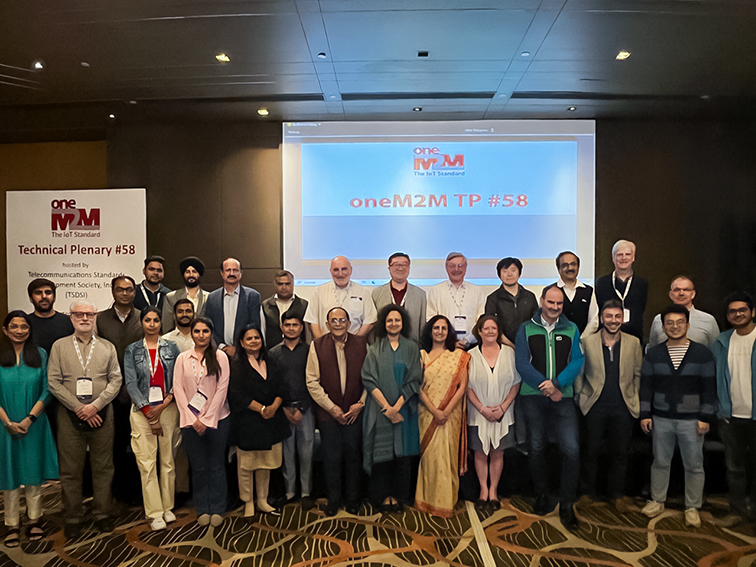 In this interview, Roland Hechwartner summarizes the latest developments from oneM2M’s recent Technical Plenary #58. In addition to representing Deutsche Telekom (DT), Roland is the Chairman for oneM2M’s Technical Plenary (TP) and responsible for the coordination of the overall management of the technical work within the TP and its Working Group.
In this interview, Roland Hechwartner summarizes the latest developments from oneM2M’s recent Technical Plenary #58. In addition to representing Deutsche Telekom (DT), Roland is the Chairman for oneM2M’s Technical Plenary (TP) and responsible for the coordination of the overall management of the technical work within the TP and its Working Group.
Q: What were the key features of this TP?
RH: oneM2M’s Indian Partner, TSDSI, hosted this meeting in New Delhi, India, from 20 to 23 February 2023. The meeting continued the close collaboration between India and the European Union with generous support from the EU-funded India-EU project on ICT standardization.
TP58 was held as a hybrid meeting for all TP and working group (WG) sessions. I will summarize the WG sessions later on. The opening plenary contained very good news about oneM2M’s security specifications and the ITU-T which I will describe in more detail shortly.
The week-long gathering included a Stakeholders Day organized by TSDSI. The aim of this was to provide a forum where representatives from Indian industry and government organizations as well as oneM2M could exchange ideas. The discussions covered topics such as IoT requirements, developments, and solutions. It has been several years since oneM2M held an international gathering in India and this event featured open and lively exchange among presenters and well over a hundred in-person and remote participants.
Q: Let’s begin with your news about oneM2M and the ITU-T. What happened there?
RH: You might be aware that oneM2M has been working with the ITU-T’s Study Group 20 (SG20). For several years. SG20 focuses on the Internet of things (IoT) and smart cities and communities (SC&C). Rana Kamill of BT has led much of oneM2M’s contributions on IoT security. After a great deal of hard work, the good news is that oneM2M’s Security specification in TS-0003 Release 2, has been approved as part of the already transposed release 2 specifications. “Transposition” carries a special meaning that effectively corresponds to endorsement. The full set of Release 2 specifications has now been approved by the ITU-T SG20 and soon will be published by them. There will be more news in the coming weeks so readers should watch out for the background and details.
Q: Returning to usual activities, what were the highlights from oneM2M’s other working groups?
RH: I will begin with the Requirements & Domain Models (RDM) working group which is active on Release 5 initiatives. The work item on system enhancements to support AI capabilities is 90% complete. There is general agreement on IoT requirements arising from this analysis and these will feed through to oneM2M’s formal requirements specifications document.
The RDM WG also agreed on an initial baseline document for the metaverse IoT work item. There was a decision to keep the requirements work and use case development open for new input. This includes activities on existing work items like meta IoT as well as new work on digital twins.
Q: And what developments occurred in the other two working groups?
RH: I spoke of the final steps to ratify Release 4 in our last discussion. As a result, the focus of the System Design & Security (SDS) working group shifted to Release 5, where TR-0065 “Study of SensorThings API Interworking” has progressed. There is also a new baseline document of the TS-0001 “Functional Architecture” 5.1.0.
Updates to the Release 5 versions of other technical specification documents include TS-0004 “Service Layer Core Protocol”, TS-0022 “Field Device Configuration”, TS-0033 “Interworking Framework”, and TS-0034 “Semantics Support”.
One of the goals of the Testing & Developers Ecosystem (TDE) working group is to expand the user community. Among other ideas, they are looking into supporting oneM2M hackathons. During this TP, TDE members spent some time on discussing evaluation criteria to apply in a forthcoming oneM2M Hackathon.
Another TDE activity is to make oneM2M documents more accessible and user friendly. To this end, there was a discussion on creating a oneM2M Icon Set. Each of the main oneM2M entities should be represented by an easy-to-use icons in order to add recognition value when presenting specifications, educational material, brochures, or other similar documentation. The goal is to make this icon set available with Release 5. There will also be usage guidelines included to guide the creation of architectures using these icons. These activities will fall within a work item proposed by two members, Exacta GSS as well as DT, supported by Hansung University, KETI, and C-DAC (Centre for Development of Advanced Computing).
As we were meeting in-person in India after a long time, one of the TDE sessions was opened to non-members and dedicated to exploring how oneM2M could grow its engagement with educational organizations since we are seeing several oneM2M courses and student events being organized around the world. One of the topics of discussion was on establishing a framework to formalize the oneM2M-Academia Relationship. One goal is to foster closer collaborations in the development of support tools for oneM2M. Other topics included the maintenance of open-source implementations of oneM2M as well educational support in the form of hackathons and courses. At the closing session of the TP, there was an agreement to create an ad hoc group which would be open to all interested organizations, universities, and start-ups. As part of oneM2M’s procedural rules, we will formally establish this group at the next TP in April.
Q: To close, what are the plans for the next TP?
RH: The next TP meeting is scheduled for April 17-21 and will be held as an online only meeting. Before we create the oneM2M-Academia Relationship ad-Hoc group, there will be elections for several open chair and vice chair positions and run for a two-year term.
Content wise, the focus will be on progressing Release 5. We expect contributions covering work items related to Smart Lifts, SDT based Information Model and Mapping for Vertical Industries, Meta-IoT, and possibly new work item proposals.

